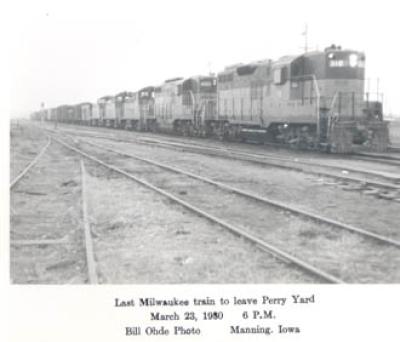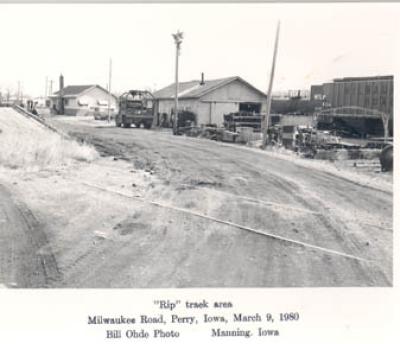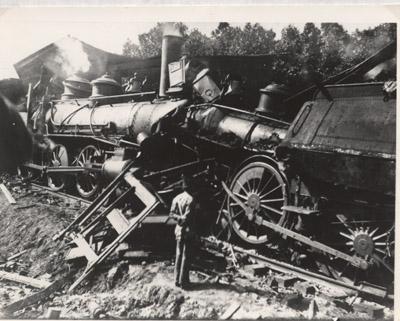|
Hello readers and welcome back to the Hometown Heritage blog!
Many of you, like me, probably remember when Perry used to have a railway instead of a bike trail. There used to be the whistle of a train near every-day and cars would have to wait for the trains to pass. The Milwaukee Road, as evidenced in the art in the Hotel Pattee, used to pass through here as well. In fact, I found some interesting pictures about the Milwaukee Road in our collection! First, we have a picture of the last Milwaukee train to leave Perry on March 23, 1980 at 6 P.M. Although not that interesting of a photo, it shows the slow progress of the railroad leaving Perry. The next photo, however, creates some questions for me. The picture is also of the Milwaukee Road, but has a note that says it is the “Rip” Track Area. From the looks of the picture, it seems to be an empty road, with a bit of track near the bottom of the picture. This is where my questions start! I looked up what a “Rip” track is supposed to be and according to Wikipedia it is short for “repair inspect paint” track. Yet to me, it seems like there is no track here! In addition, the picture is dated to 1980, the same year when the last Milwaukee train left Perry! Perhaps this means that it is the ripping up of the train tracks in this area? It would definitely appear this way, since the area is covered in dirt and the track at the bottom is covered up. However, I do not know for sure, as our database does not provide much information. Since this happened in 1980, perhaps some of you readers may know? If you do, please let us know in the comments, and join us next week for another blog post!
1 Comment
Hello and welcome back to the Hometown Heritage!
The date is August 6, 1902, and you are boarding the train on the Milwaukee line heading to Milwaukee. It is a sunny afternoon, and everything seems normal. As you board the train, you can see engineers and other workers rushing around preparing the train for departure. As the whistle blows signaling the train will be leaving the station soon, you hurry toward your seat and place your baggage above you on the rack. You then settle into your seat, ready for what you assume will be a standard trip on the train. Little do you know, this train will never make it to its final stop. An hour or so passes on the train, and everything seems normal. People talk in hushed tones around you, keeping mostly to themselves. The conductor, having collected all the tickets, returns from the back of the train, heading toward the front. As you watch him walk past, you wonder what he does during the trip and admire his fancy hat, but soon return to the book you brought with you. More time passes, and you hear the train whistle blow loudly as the train pulls into the station. Seeing that this is the station at Collins, you return to your book, not paying much attention to those boarding and disembarking. Your eyes grow heavy, and soon you fall asleep as the train pulls out of the station. The train lets out an ear-piercing whistle, jarring you awake. You look out the window, and are surprised to see that the train is not near a station at all. Another shrill whistle sounds, and it fills you with a sense of urgency. You try to lean as close to the window as you can to get a glimpse of what is ahead, but you cannot see anything. A third whistle sounds: now other people on the train are starting to talk. Everyone can feel something in the air, but no one knows what exactly it is. A fourth whistle, even more urgent sounding than the third, and suddenly you are thrown from your seat as the sound of metal crashing into metal fills the air. Chaos ensues as people are flung about the train. Your head pounds, and as you put your hand to your temple you feel a hot, sticky liquid and pull your hand back to see your fingers coated in red. The conductor, his clothes a mess and without his hat, comes back through the train, asking people to quickly and quietly leave the train. You do as he asks, and as you move down the train you seem some people following his advice, while others sit eerily still. Once off the train and a fair distance away, you look and it finally dawns upon you that you have just survived a horrible train wreck, one in which some people will not be leaving alive. Although this may not have been exactly how it happened, a train wreck did occur on August 6, 1902 between Collins and Rhodes Iowa. As you can see in the picture, the locomotive is in a bad state, having just run into a work train. Nine people, including an engineer from Perry, died in the crash. Although our records do not state the exact details of the crash, it seems likely that the work train was not supposed to be on the tracks. In reality, only those on the train could have known what truly happened, but who knows, maybe my description is closer than I think! As a reminder, the next Gary Ernest Smith event is on October 13th at the Hotel Pattee from 4:30 – 6:30! This time Adrienne Gennett, the Assistant Curator of Collections and Education at University Museums in ISU will be here! I hope to see you there! |
Archives
March 2020
Categories
All
|
All Rights Reserved, Fullhart Carnegie Charitable Trust, 2014-2023
This website is possible with the support of the
Dallas County Foundation
This website is possible with the support of the
Dallas County Foundation




 RSS Feed
RSS Feed